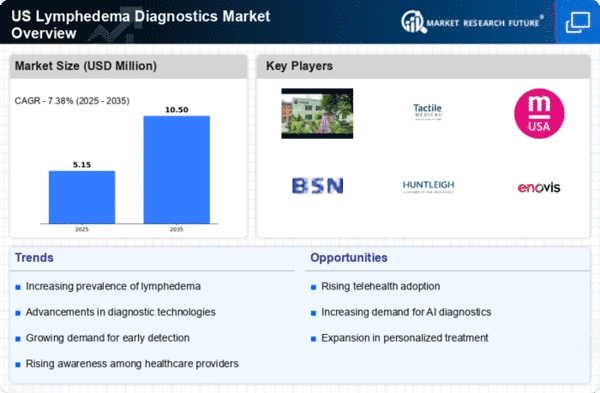Growing Healthcare Expenditure
The rising healthcare expenditure in the US is a significant driver for the lymphedema diagnostics market. With healthcare spending projected to reach approximately $6 trillion by 2027, there is a growing emphasis on early diagnosis and management of chronic conditions, including lymphedema. Increased funding for healthcare services allows for the procurement of advanced diagnostic equipment and technologies. This trend is likely to enhance the availability of lymphedema diagnostic services across various healthcare settings, including hospitals and outpatient clinics. As healthcare providers invest in better diagnostic capabilities, the market is expected to expand, catering to the needs of a larger patient population.
Rising Incidence of Lymphedema
The increasing incidence of lymphedema in the US is a primary driver for this market. Factors such as an aging population and the prevalence of conditions like cancer and obesity contribute to this rise. According to recent estimates, approximately 3-5 million individuals in the US are affected by lymphedema, which underscores the need for effective diagnostic solutions. As awareness of the condition grows, healthcare providers are more likely to seek advanced diagnostic tools to identify and manage lymphedema early. This trend is expected to propel the market forward, as more patients seek diagnosis and treatment options, thereby increasing demand for innovative diagnostic technologies.
Supportive Government Initiatives
Supportive government initiatives aimed at improving healthcare access and quality are positively impacting the lymphedema diagnostics market. Programs that promote early detection and management of chronic diseases, including lymphedema, are gaining traction. Federal and state funding for research and development in diagnostic technologies is also on the rise, which may lead to the introduction of innovative solutions in the market. Additionally, public health campaigns aimed at raising awareness about lymphedema are likely to encourage more individuals to seek diagnostic services. As these initiatives continue to evolve, they are expected to create a favorable environment for the growth of the lymphedema diagnostics market.
Advancements in Diagnostic Technologies
Technological advancements in diagnostic tools are significantly influencing the lymphedema diagnostics market. Innovations such as bioimpedance spectroscopy, near-infrared imaging, and advanced ultrasound techniques are enhancing the accuracy and efficiency of lymphedema diagnosis. These technologies allow for non-invasive assessments, which are increasingly preferred by both patients and healthcare providers. The market is projected to grow as these advanced diagnostic solutions become more widely adopted. Furthermore, the integration of artificial intelligence in diagnostic processes may streamline workflows and improve patient outcomes, thereby driving market growth. As healthcare systems prioritize precision medicine, the demand for sophisticated diagnostic tools is likely to increase.
Increased Focus on Patient-Centric Care
The shift towards patient-centric care in the US healthcare system is driving the lymphedema diagnostics market. This approach emphasizes personalized treatment plans and improved patient engagement, which necessitates accurate and timely diagnostics. Healthcare providers are increasingly recognizing the importance of involving patients in their care decisions, leading to a demand for diagnostic tools that provide clear and actionable insights. As patients become more informed about their health conditions, they are likely to seek out diagnostic services that align with their preferences. This trend is expected to foster growth in the lymphedema diagnostics market, as providers adapt to meet the evolving expectations of patients.

















Leave a Comment